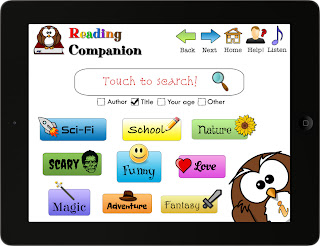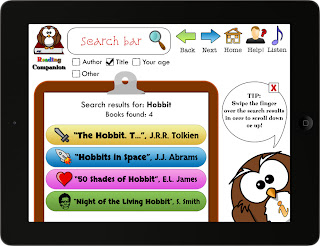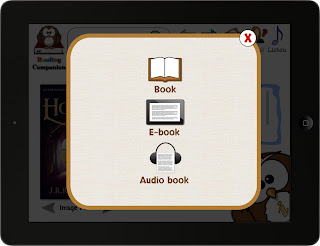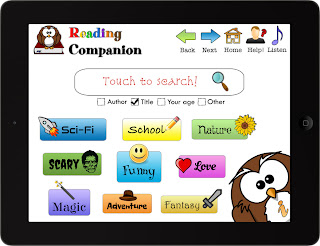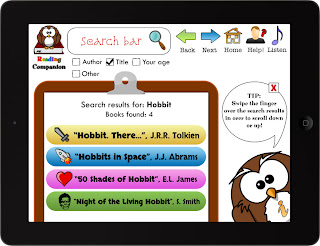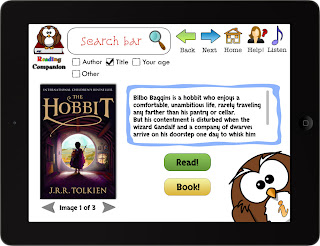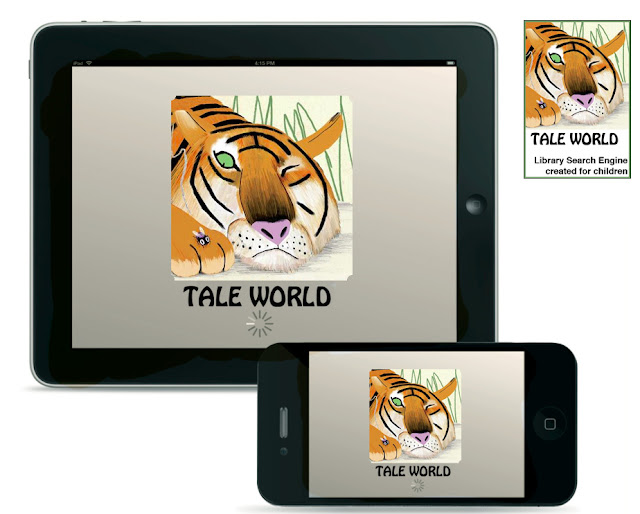When trying make a suitable application we needed good personas, a target group that were on the school and had nothing to do during their break. In the animation a school friend suddenly enters and talks about the “new cool place called a library”, all kids goes there and falls in love with the place. This helped us a lot and made the application easier to produce because we had “real” persones in mind when implemented new functions in the program.
The link to the animation: http://goanimate.com/videos/08-j4hB5_wTw/1
"The Mediated Library"
Thursday 7 March 2013
Tuesday 5 March 2013
Remaining problems
Remaining problems from Mid crit.
1. Funding: how much can we spend?
1. Funding: how much can we spend?
Children are a worthwhile “investment”. Children’s libraries need a budget to maintain and improve the quality of materials and services offered to the public.
Standard budgets can be supplemented with outside sources of funding, such as:
government grants (for special programs and new initiatives)
cultural organisations (for music, dance, drama, arts, historical and ethnic presentations)
publishers (for visits by authors or illustrators and for other give-aways)
sponsorship (local businesses and volunteer organisations to support specific events)
non-governmental agencies
matching funds.
2. Architecture: can we really redesign the building itself?
Ideally, the library for pupils should be centrally located. it would be better to have designed space for reading area as well. However, according to teachers in our target school, we have a limitation of space and it might be impossible to expand the room or take a larger room for the library. So creativity of designing the reading space can go a long way. For example, furniture such as knock-down furniture that can be composed freely to make relatively closed space, as well as create novelty of the surroundings.
3. Changing just the library may not solve many problems, as it is the part of the whole educational ecosystem: maybe the whole system should be redesigned as well?
Keep children reading in the library
Our target audience for the school library is pupils in Vinstaskolan primary school. According to our targe school, the most significant problem is that children dislike the school library and even reading. This is probably a common problem for a lot of primary school libraries.
We propose the library to provide materials like:
4. Creative programming and storytelling
The goal of our project is to design a mediated library for pupils in school which is supposed to be attractive and children-friendly, thus to attract and keep children reading by providing technologies in this library. We recommend that the library should improve its materials, spaces and services in order to be appealing to children through meeting children’s reading needs.
Children say that the most important reason why they do not like reading in school libraries is that they cannot find books they like. ①Therefore we believe that the scale of reading resources for children and freedom of choosing books they really like could make them motivated to read and feel less uncomfortable in a school library. Whatever kind of a book would be great such as fantastic fictions, manga, comics, sport magazines, etc. as long as children are reading. As well as whatever kind of medium or surface would be no problem like smartphones, laptops and tablets can be use to keep children reading.
Materials
The reading landscape in the 21st century stretches far beyond the boundary of physical printed books. We are surrounded by multiple literacies, from reading online to participating in virtual classrooms, and, as such, our notion of traditional literacy has expanded. While reading, writing, arithmetic skills are still the basics for children.
Scholastic’s 2008 Kids & Family Reading Report studied the factors shaping children’s relationships with reading in the 21st century. Among their findings:
*After age eight, more children go online daily than read books for fun daily.
*Kids between the ages of five and 17 are not about to give up on printed books.
*Three-quarters of kids of all ages agree that “no matter what I can do online, I’ll always want to read books printed on paper. ②
Thus the library should include a variety of developmentally appropriate materials in all formats for children to choose, especially internet-connected devices. We propose that using both the hardware and software to display and interface with digital text. Hardware includes devices, such as e-readers and tablets, as well as smartphones, laptops, and even desktop computers, that display digital text. Software includes a range of applications and programs that allow readers to interact with the text, either locally on the device or over a network; it may or may not include instructional features.
We propose the library to provide materials like:
*Printed materials: books, periodicals, comics, brochures.
*Media: CDs, DVDs in order to provide children with audio books.
*Toys
*Learning games
*Digital readers: interactive furniture, tablet, etc.
In the first place, the materiality of the average book is far more important to a child than an adult. Adults don't much mind if they get their 80,000 words of continuous prose on a screen or a printed page but digital readers for children should have the screen-space that lets text and illustration breathe together but it has not been cared so much yet. On the other hand, new technology can deliver excitements to children that paper can't: a book with moving pictures, or pictures that talk to readers when they press them, or–for older children, learning to read – a book that allows them to touch a tricky word and hear it read aloud.
*Software:
Navigation application
Recording application: A software that lets readers record themselves reading a story, as if they were the actual character, is a fun and interactive way to engage young minds. For instance, children can hear their friend’s voice when reading the book as one role in the book and they can record their voice as another role to interact with friends. It captures a child’s attention and encourages a connection to the story and the reader. There are proven tips to get children to read by taking turns reading aloud. ③
*Connectivity:
The internet connection can make children connected with both books as well as other readers. For instance, each child has his/her own account in the school library which records his/her reading list and progress in the book. They can share their lists with friends and also follow their friends’ reading progress. Keeping in touch with each other they know can also make reading not a boring lonely work but an interesting sharing activity with friends and classmates, which might motivate children to read more and expand their reading fields and interests.
Meanwhile, using the Internet could leverage a positive reading experience for children. Encourage kids to extend the reading experience online in order to fuel a positive reading experience and enhance their connection to the book. For example, visit an author’s website and let the children get immersed in the content related to their favorite books. They can sample new reads or share reviews with other fans and maybe find an author’s podcast about how the story idea was born.
We believe that technology can make children reading in the library. It helps young readers interact and connect with what they are reading, which is key to engaging a reader. The varieties of visual and audible forms help children access the content in different ways rather than just through pictures and text. This helps them stay in the game of reading, especially for boys who thrive on visual language. While it will always be hard to beat the loving interaction between a parent and child reading a book together, the variety that technology offers in the reading experience may help kids understand that reading matters more than ever.
Space
A libraries with open, inviting, challenging and non-threatening environment is obviously attractive to children to visit and stay.
Distinct from other parts of the school. We propose that both open and relatively small separate space are needed in the library. Thus pupils could choose their own prefer space when reading. for example, knock-down or furniture can be composed freely to make relatively closed space, as well as create novelty of the surroundings.
Furniture: safe, sturdy, good quality, suppor equality of access, flexibility, remember tastes change, shelving.
Services
The library should meet the information, cultural and entertainment needs:
1. (Navigation application?) Offering information and reference services to help children select materials: As mentioned before, Children say that the most important reason why they do not like reading in school libraries is that they cannot find books they like. The best way to get kids reading more is to give them books that they'll gobble up -- and that will make them ask for another. The aesthetic appreciation many adults have for books doesn't come as naturally to young children. So letting children find and pick what they really like is important in the library.
2. involving children in the selection of materials and development of library services.
3. Motivating activities:
*Kimber Brown, a program director for Teach for America, says the incentive to read is different for every child. "For anyone to be motivated to do anything, they have to believe two things: (1) They have to believe they can do it, and (2) they have to want to do it". ④Some kids may be motivated by a sticker on the chart, while others may need the promise of a more tangible prize, like a trip to the community pool or zoo, to catch their attention. We believe that in the mediated library where children's reading information in the library can be chosen by their own to show to their parents through the Internet through which they may get rewarding from that.
*Devote one period a day to kids -- and their teachers -- doing nothing but reading, and mostly reading what they want to.
*Create a library of student-published and student-illustrated books. Kids love books written by their peers. As fan fiction has explored mostly by children and young teenagers, it is an encouraging example of the way creative reading and creative writing can become the centre of an online community. Offering a model of children involvement in reading and writing.
*Give children library cards and digital library account. Not only will they feel more grown up, but they'll feel a sense of accomplishment and possession over their reading abilities.
4. Creative programming and storytelling
5. Memory bank: All children learn to read at a different pace. Instead of asking them to finish a certain number of pages, using the memory bank to record and set aside a chunk of time during which they should read. If it's a race to the finish, nobody wins.
According to the the fourth edition of the Kids & Family Reading Report, technology could increase reading among children. For example, about one-fourth of the boys who had read an e-book said they were reading more books for fun. Boys have traditionally lagged behind girls in reading. Also, half of those in an older age range, from 9 to 17, said they would read more books for fun if they had greater access to e-books. Children said e-books were particularly good when they wanted to be secretive about reading. ⑤ As a mediated library with interactive technology and reading programs, it probably could keep young readers reading in the library as well as motivating non-readers to start reading.
Reference:
Tablet App!
Hope you will like it! Of course, we can still modify the design if we will find it necessary :)
If you'd like to make any changes, feel free to do so! You can download the PSD file (Photoshop) here: https://dl.dropbox.com/u/13997175/LibraryApp.zip
EDIT: Added the suggested questions.
EDIT #2: Another update! Added [x]/close button.
If you'd like to make any changes, feel free to do so! You can download the PSD file (Photoshop) here: https://dl.dropbox.com/u/13997175/LibraryApp.zip
EDIT: Added the suggested questions.
EDIT #2: Another update! Added [x]/close button.
Friday 1 March 2013
Navigation Program:
SLOGAN
~ What would you like to read? ~
"HELPER" IMAGE The Lion
STARTING PAGE
- "Helper" image: options to show/hide the helper
- Additional basic buttons: Back, Forth, to the start, ask for teacher's help
- textual advice/instruction: to type the text into the search box OR to choose the button with the theme: each button looks like a logo with the special color - being a symbol of a particular literature Genre: sci-fi, humour, adventure, scary stories, magic, nature, school books etc.
- separate listing of options: to search using Name, Title, Hero's name, key words, "MustRead at the age of 6, 7, 8, 9, 10, 11, 12"
Visual design: buttons, "Helper", search box
SEARCH RESULT PAGE - 1st STEP - LIST OF BOOKS
After the rubric is chosen/search text is entered, the Offering least appears:
- Horizontal scrolling
- variants are segmented and separated with colors and logos according to the genre
- Preview picture of books with the short descriptions of stories
SEARCH RESULT PAGE - 2nd STEP - THE BOOK
Book cover, teaser, picture gallery, Options: "book", "download"
+
After one has downloaded the book, the commentary appears: "Thank you! This book is like another cool one, "***", and we have it!"
P.S.
various buttons, rephotoshopable
"HELPER" IMAGE The Lion
STARTING PAGE
- "Helper" image: options to show/hide the helper
- Additional basic buttons: Back, Forth, to the start, ask for teacher's help
- textual advice/instruction: to type the text into the search box OR to choose the button with the theme: each button looks like a logo with the special color - being a symbol of a particular literature Genre: sci-fi, humour, adventure, scary stories, magic, nature, school books etc.
- separate listing of options: to search using Name, Title, Hero's name, key words, "MustRead at the age of 6, 7, 8, 9, 10, 11, 12"
Visual design: buttons, "Helper", search box
SEARCH RESULT PAGE - 1st STEP - LIST OF BOOKS
After the rubric is chosen/search text is entered, the Offering least appears:
- Horizontal scrolling
- variants are segmented and separated with colors and logos according to the genre
- Preview picture of books with the short descriptions of stories
SEARCH RESULT PAGE - 2nd STEP - THE BOOK
Book cover, teaser, picture gallery, Options: "book", "download"
+
After one has downloaded the book, the commentary appears: "Thank you! This book is like another cool one, "***", and we have it!"
P.S.
various buttons, rephotoshopable
Wednesday 27 February 2013
Application prototype
Guys, that's what I know how to do.
I can do an application for the Library Search Engine.
I can create the design and visual & textual description of its basic functions. If you are OK with this idea, I will post the drafts of each slide here, and we'll discuss/edit them.
I can do an application for the Library Search Engine.
I can create the design and visual & textual description of its basic functions. If you are OK with this idea, I will post the drafts of each slide here, and we'll discuss/edit them.
Subscribe to:
Posts (Atom)
